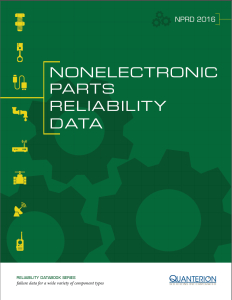 The 2016 Edition of the Nonelectronic Part Reliability Data publication (NPRD-2016) presents failure rate data on a wide variety of electrical assemblies and electromechanical/mechanical parts and assemblies. Compared to its predecessor NPRD-2011 publication, NPRD-2016 adds 138,000 new parts and over 370 billion part hours, representing approximately a 400% increase in content. The expanded part types and data in NPRD-2016 cover ground, airborne and naval environments.
The 2016 Edition of the Nonelectronic Part Reliability Data publication (NPRD-2016) presents failure rate data on a wide variety of electrical assemblies and electromechanical/mechanical parts and assemblies. Compared to its predecessor NPRD-2011 publication, NPRD-2016 adds 138,000 new parts and over 370 billion part hours, representing approximately a 400% increase in content. The expanded part types and data in NPRD-2016 cover ground, airborne and naval environments.
Accurate and timely reliability predictions are an important part of a well-structured reliability program. When properly performed, they can provide valuable insight into the design and maintenance of reliable systems. While there are well-accepted reliability prediction methodologies for standard electronic components such as MIL-HDBK-217, “Reliability Prediction of Electronic Equipment” and the 217PlusTM System Reliability Assessment methodology (currently at 217PlusTM:2015), there are few such sources of failure rate data for other component types. A potential use for this document is to complement existing reliability prediction methodologies by providing failure rate data in a consistent format on various electrical assemblies and electromechanical/mechanical parts and assemblies. Although the data contained in this publication were collected from a wide variety of sources, everything possible has been done to screen the data such that only high quality data is added to the database and presented in this document. In addition, only field failure rate data has been included. The NPRD-2016 user should note that the use of any reliability prediction technique, or the use of the data contained in this book, should complement (not replace) sound reliability engineering and design practices.
NPRD-2016 provides historical reliability data on a wide variety of part types to aid engineers in estimating the reliability of systems for which their own data does not already exist. Sound reliability engineering practices must include knowledge of the failure physics of all critical components, modules and interconnection assemblies in a system. Knowledge of life-limiting failure mechanisms and how these mechanisms will behave in the intended use environment is also necessary. Only in this manner can robust designs be ensured.

